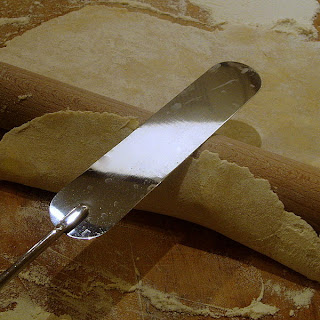
It's
British Pie Week (2nd-8th March)!
It would be a sacrilege to let this pass without acknowledging it. And what a great excuse to make a pie on a wet, miserable and cold day.
Also, pie-making seems to have been designed to fit with my fifteen-minute breaks (almost)!
Here's my recipe for
Steak and Mushroom (with a little bit of Ale) Pie, the filling is made up from things that I happened to have in the cupboard/freezer and doesn't follow a particular recipe. I hope it works! The pastry on the other hand follows
Delia's recipe, which is tried and tested.
First break (15 mins)
Filling ingredients:
1 small red onion, chopped
2tbs olive oil
400gr local stewing steak tossed in 1tbs of well-seasoned flour
200gr local mushrooms
A small handful of porcini mushrooms
1/2 tsp thyme (dried) or a couple of fresh sprigs
2 tbs mushroom ketchup
75ml port (all that was left in the bottle)
1 beef stock cube
1 can Guinness.
Start by putting the oven to preheat (170 degrees). In an ovenproof dish (I used a small-ish Le Creuset) heat the oil then add the onion. Cook the onion until its soft. Add the steak, mushrooms and thyme and cook for a couple of minutes. Then add the liquid (port, mushroom ketchup and Guinness) along with the stock cube. Bring to the boil, then cover and place in the oven. Return to work and enjoy the smell of it bubbling away...
Second break (15 mins)After an hour give the meat a stir and then make the pastry. I followed
Delia's recipe, but I used all butter (as I didn't have any lard) and I doubled the quantities to make sure that I had enough. If there's some left over it will always keep. Put in the fridge to rest. Then remove the lid from the meat for the last 45 mins to allow the liquid to thicken.
I've been getting quite stressed this evening about how much I still have to do for the PhD. Sometimes I'm fine and other times it completely overwhelms me. But, standing there rubbing the butter into the flour was really quite therapeutic. I think that allowing myself the pleasure of cooking (in rationed amounts) is really helping me to keep calm about it all. At least at the moment it is. Third break (10 mins)
After 30 -40 mins (I know, it's not an hour) take the meat out of the oven and leave to cool slightly.
Meanwhile, take the pastry from the fridge, cut it in half and roll out the first half so that it will cover a pie plate. I just use an enamel plate with a slight lip which I brought from a kitchen shop last year, but I've seen them in camping shops too.
Spray the plate with some olive oil (we have a pump and spray bottle - you can get them from Lakeland) to stop it sticking.
Then, use a palette knife to get the pastry onto the rolling pin , it makes it easier to transfer the pastry to the plate.
Cut-off anyexcess and brush the very edge with egg.
Put some of the filling in the the centre, I've just realised that the filling will easily make two pies, so put the remainder in a tub for the freezer.
Roll out the other half of the pastry and place on top.
Trim the excess pastry.
Go round the edge of the pie pressing the back of a fork into the pastry to seal it. Then brush the top with egg, prod it with a fork three or four times and pop it in the oven at 190 degrees for 45-50 mins. I have an awful electric oven at the moment which is generally quite slow to cook things, so you may find it cooks more quickly than this in your own oven.
Verdict?If anyone has any improvements, let me know!



















 of it, but, after being told about the ingredients (onion, herbs, spices, barley, salt, etc), the history of it and the nutritional qualities I plucked-up the courage to try some. It’s not something I’ll be eating all the time, but it was not as bad as I thought it would be!
of it, but, after being told about the ingredients (onion, herbs, spices, barley, salt, etc), the history of it and the nutritional qualities I plucked-up the courage to try some. It’s not something I’ll be eating all the time, but it was not as bad as I thought it would be! 
























